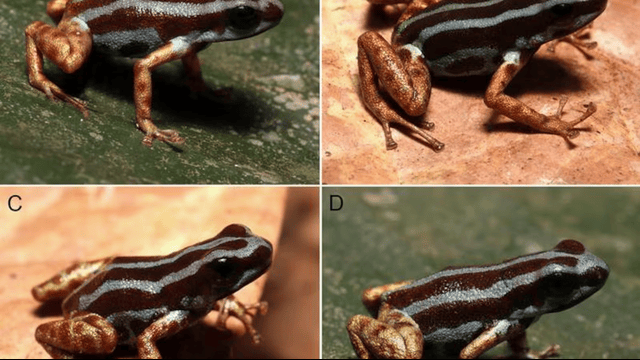
Researchers have discovered a new kind of poison dart frog deep in Brazil's Amazon rainforest. CTV News
A group of scientists from Brazil and the Czech Republic has discovered a stunning new species of poison dart frog. They found it deep in the Amazon, near the Juruá River in western Brazil. This little frog stands out because of its glowing copper-colored legs and bright blue stripes. The team said the frog looked so beautiful, it seemed “not from this world.”
They named the new frog Ranitomeya aetherea. The name “aetherea” comes from the Latin word for “heavenly.” The scientists chose it to match the soft blue color of the frog’s back, which reminded them of the sky. They said the frog’s charm and gentle look made it feel magical.
Unique Features and Sounds
The researchers studied the frog’s body, size, colors, and even its tadpoles. They also listened to the sounds it makes. The frog has different calls, like one to attract mates and one to mark its presence. The team compared it with 16 other types of Ranitomeya frogs already known. The new frog was clearly different, especially because of its special color pattern.
Only one other frog from the Ranitomeya group has been discovered in the past 10 years. That frog, found by some of the same scientists, was named Ranitomeya aquamarina. It had a sea-blue and green color, reminding the team of aquamarine gemstones. They chose that name to show how rare and valuable the find was.
Found in a Hard-to-Reach Region
The two new frogs were both discovered in the same area—around the Juruá River and nearby streams. This part of the Amazon is very hard to explore. Scientists say it is one of the least studied places in the rainforest.
To learn more about this region, scientists are using new research methods. One of these is the RAPELD system. It helps them study biodiversity in a faster and more organized way. Thanks to these methods, scientists have started to find new species like the aetherea.
So far, the aetherea frogs have only been seen in a small area. But the scientists believe more of them may be living nearby. They think future studies might uncover more populations of this rare frog.
Why This Matters
New species like Ranitomeya aetherea remind us how little we still know about the Amazon. They also show the importance of exploring hard-to-reach areas. As forests face threats from deforestation and climate change, each discovery becomes more valuable. It helps us understand nature better—and gives us more reasons to protect it.















